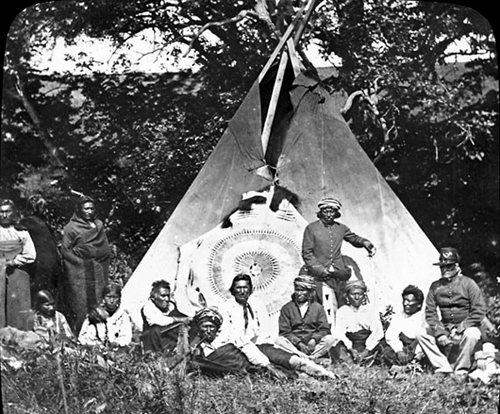
The Central Plains is the portion of the Great Plains which lies south of the South Dakota-Nebraska border and north of the Arkansas River. It includes Nebraska, Iowa, Kansas, Missouri, southeastern Wyoming, and western Colorado. After migrating from the Ohio River valley, the Siouan-speaking Omaha settled in what is now Nebraska. The name Omaha is generally said to mean “upstream, against the flow.”
Farming
Among the Omaha in Nebraska, the fields would be planted in May and tended until the corn was well established, usually late June or early July. Then the entire village would leave on the summer buffalo hunt and return to harvest the corn in September and October. The crops would be cached in underground pits for later use.
Omaha gardening was carried out by both men and women. In general, the fields ranged up to three acres in size and were located along stream bottoms. Each family had its own garden plot and as long as they continued to plant it, their right to occupy and use it was respected. In addition to corn, the Omaha also grew beans, squash, and melon.
Gathering
The Omaha gathered artichokes (Helianthus tuberosus L.) in the spring. According to Alice Fletcher and Francis La Flesche, in their 1911 ethnography The Omaha Tribe:
“They were eaten raw and were spoken of as the food of homeless boys who had no near relative to feed them.”
Some of the other plants used as food by the Omaha include the ground nut (Apios tuberose), the root of the great yellow water lily (Nelumbium luteum), the bulb of the lily (Sagittaria variabilis), and milk weed (Asclepias syriaca L.). Slippery elm bark was often used in cooking for flavoring. Mushrooms were boiled or fried in fat.
Buffalo Hunting
By the late 1700s, the Omaha had adopted a pattern of two major buffalo hunts each year: a summer hunt which began in July and would end in September and a winter hunt which took place during January-March. The summer hunt would begin after the crops had been cultivated for the second time. During the late fall – November and December – they would hunt other game in the sheltered Missouri River bottoms.
During the buffalo hunt, the Omaha would camp together as a tribe. The camp was set up according to clan membership with each clan having a clearly defined place in the camp circle. Within the camp circle, three sacred tents would be set up: the Tent of War to the south of the camp’s entrance, and the Tent of the Sacred Pole and the Tent of the White Buffalo Hide which were set up together just to the south of the center of the camp circle.
During the summer buffalo hunt, the Omaha would abandon their earthlodge villages and live in tipi villages. In these villages, the families from each clan would cluster their lodges close to each other around the perimeter of a circle. The entry to the circle was usually oriented toward the direction that the tribal camp was moving.
Villages
On the eastern portion of the Central Plains, Indian people constructed villages near major rivers and streams. An ideal village site would have timber for construction and fuel nearby as well as land suitable for farming.
With regard to the Omaha Big Village in Nebraska, archaeologists John O’Shea and John Ludwickson, in their book Archaeology and Ethnohistory of the Omaha Indians: The Big Village Site, report:
“Big Village does not appear to have been laid out following any discernible plan; rather, it seems likely that the lodges, storage pits, and corrals were clustered in the village without any apparent order, although possibly with an open area reserved in the center of the village.”
With regard to the Omaha, archaeologists John O’Shea and John Ludwickson write:
“The semipermanent earthlodge village was central to virtually all aspects of life.” In building an earthlodge, the ground was often excavated (sometimes up to a foot or a foot and a half). The floor was then tamped, and then flooded with water. Next it was covered with dried grass and burned. This tamping, wetting, and firing sequence would be repeated several times resulting in a hard floor which could be kept clean.”
A series of center poles – four, six, or eight poles – and exterior poles were used to support the roof poles. Often the perimeter poles slanted outward. The earthlodges were often 30-40 feet in diameter, though some are reported which exceed 70 feet in diameter.
In the center of the lodge was a fire which was used for cooking. Sleeping areas, described by some of the early non-Indian explorers and traders as “bunks,” “berths,” or “benches,” were arranged around the perimeter of the lodge.
According to Omaha oral tradition, they borrowed the earthlodge design from the Arikara after they moved to the Missouri River area.
Many of the Central Plains tribes, such as the Omaha, used subterranean storage pits. Some of these pits were constructed inside the earthlodges and some of them were constructed outside. Often the Omaha earthlodges had a cache just to the left of the entrance. During the summer, when the Omaha would leave the village for the buffalo hunt, they would place household items—mortars, pestles, extra hides, etc.—in the cache and carefully conceal the opening.
According to archaeologists John O’Shea and John Ludwickson:
“The primary function of these pits was the storage of agricultural produce, such as corn and beans, particularly when the tribe was away from the main village.”
In addition, they stored some tools, clothing, and equipment in the pits.
The storage pits were fairly large: up to eight feet in diameter and five feet deep. Among some groups, such as the Pawnee and the Omaha, the storage pits were bell-shaped. Ethnographers Alice Fletcher and Francis La Fleche, writing in 1911, describe a typical Omaha cache:
“This consisted of a hole in the ground about 8 feet deep, rounded at the bottom and sides, provided with a neck just large enough to admit the body of a person.”
The cache was sealed with sod. A typical storage pit could store 120 bushels of shelled corn and some were large enough to store 200 bushels.
Vision Quest
During puberty, Omaha boys would go through a vision quest known as Non’zhin zho which means “to stand sleeping.” During this ceremony, the boy would enter into a personal relationship with the mysterious power that controls all of nature. Traditionally, in the spring the boy was to spend four days in the hills, crying to Wakon’da. He was to ask no special favor, but to only appeal in a humble way to Wakon’da. Anthropologist Victor Turner, in his essay in Sacred Realms: Essays in Religion, Belief, and Society, reports:
“If they dream that they receive a woman’s burden-strap, they feel compelled to dress and live henceforth in every way as a woman. Such men are known as mixuga.”
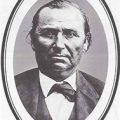
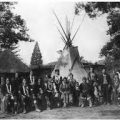
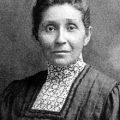
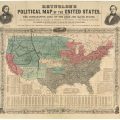
Leave a Reply